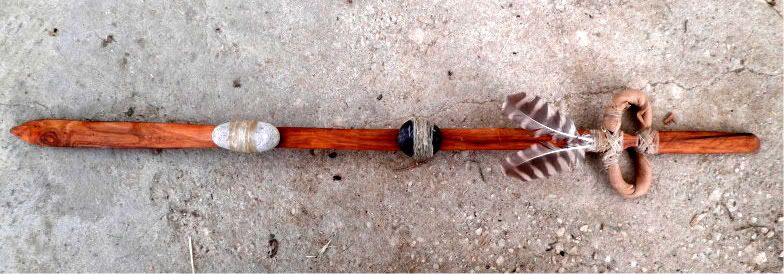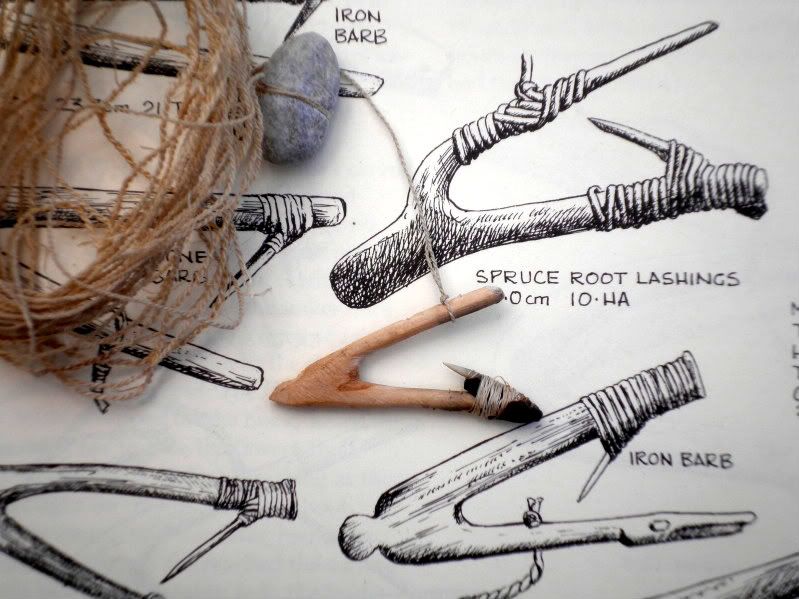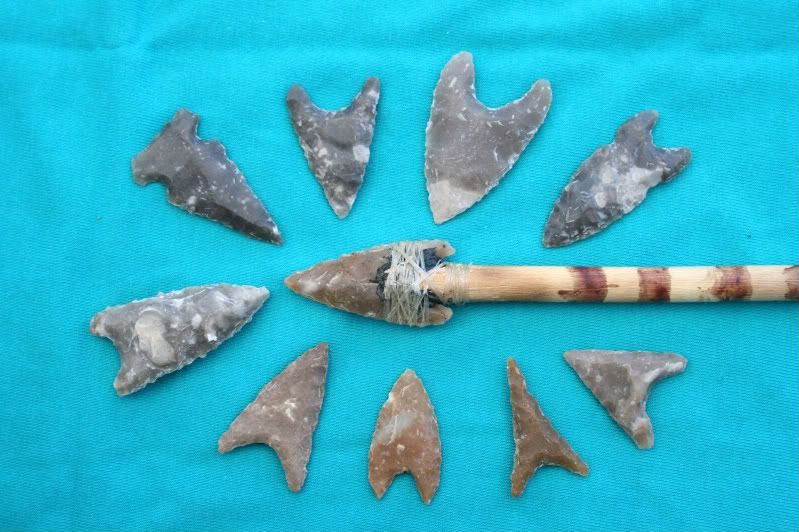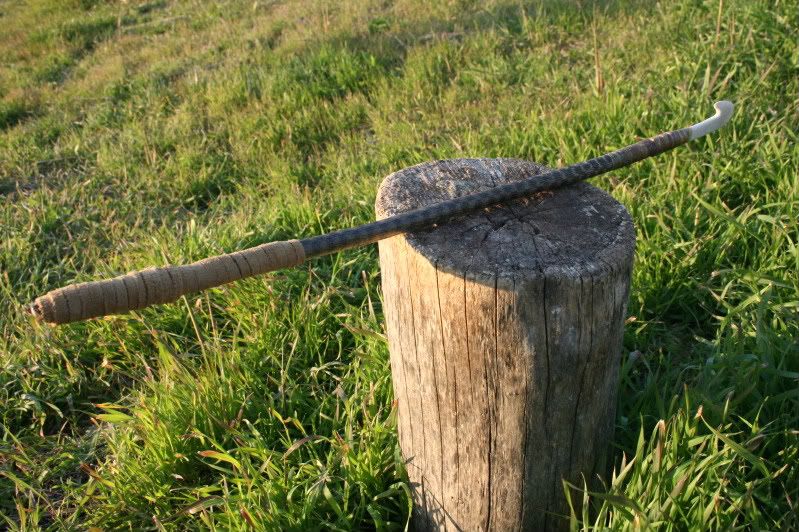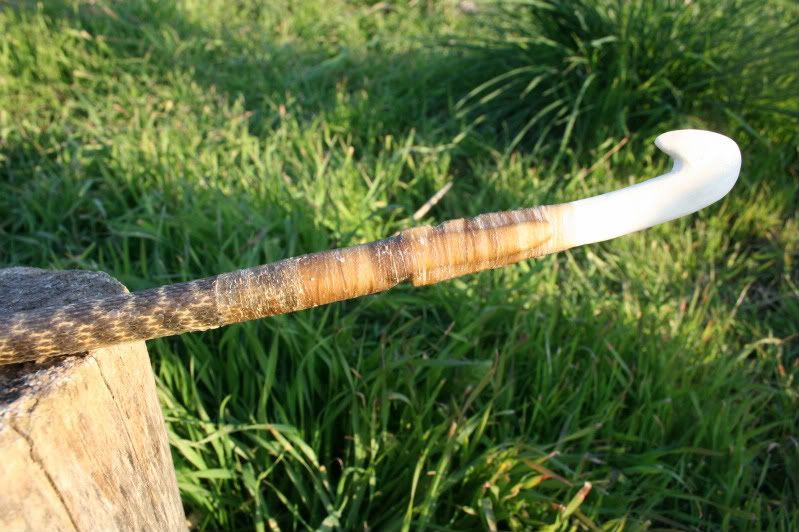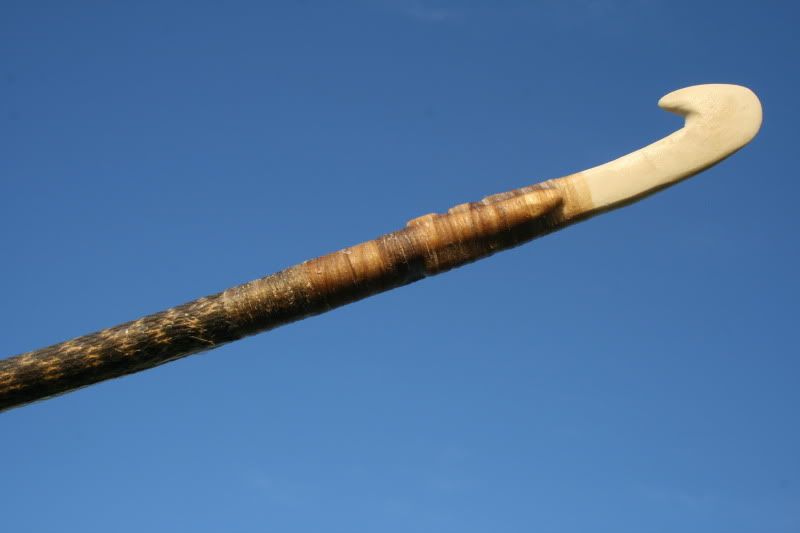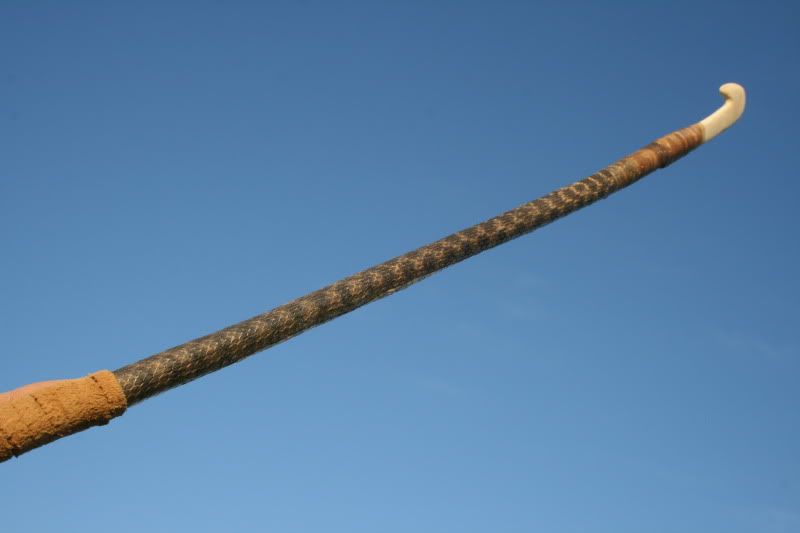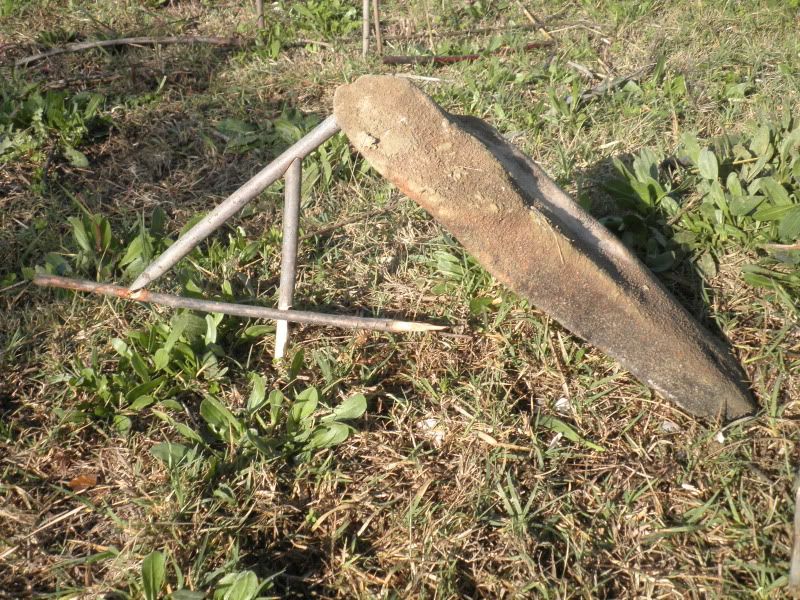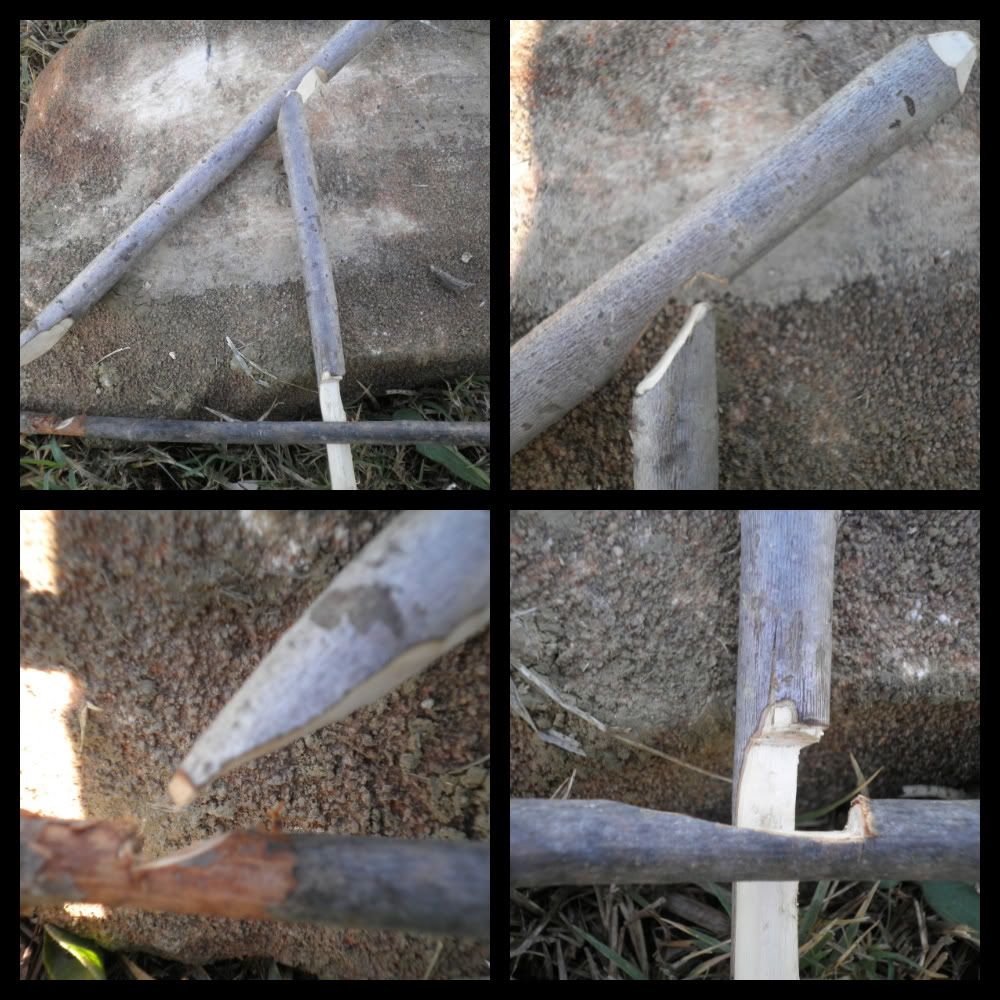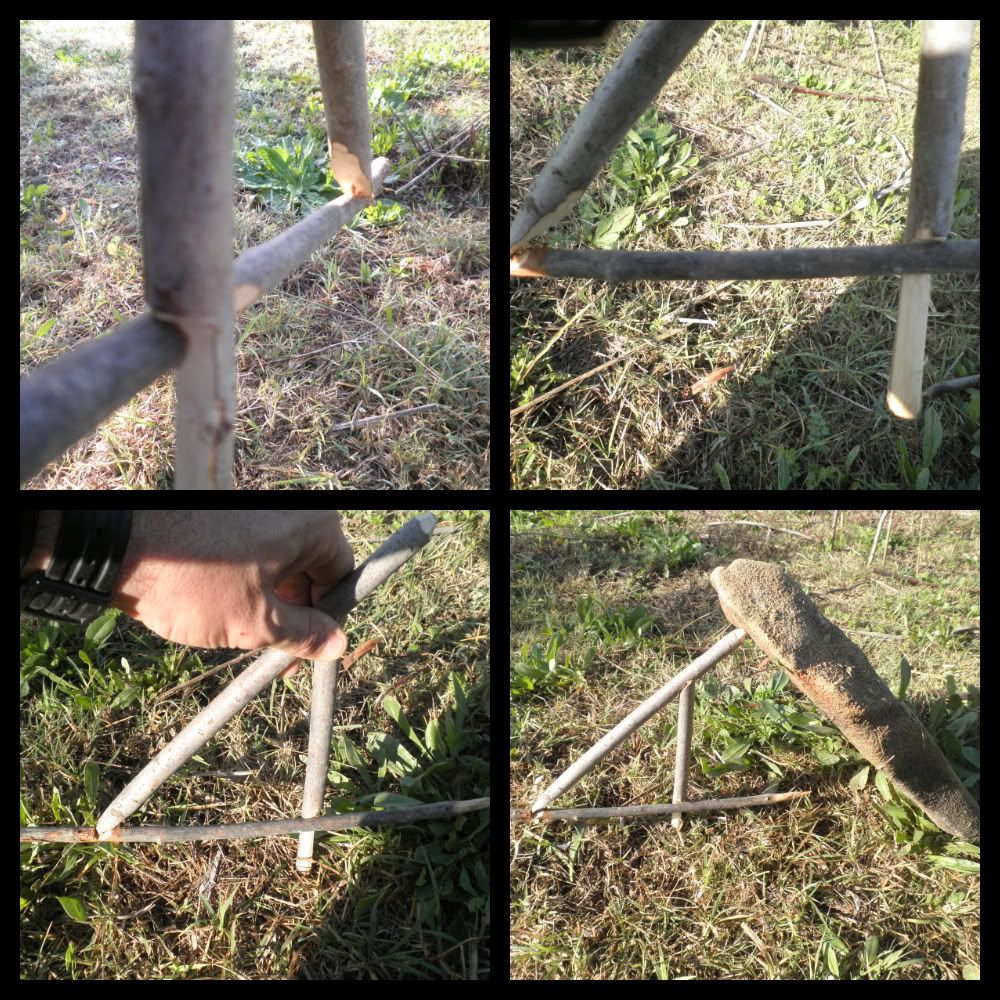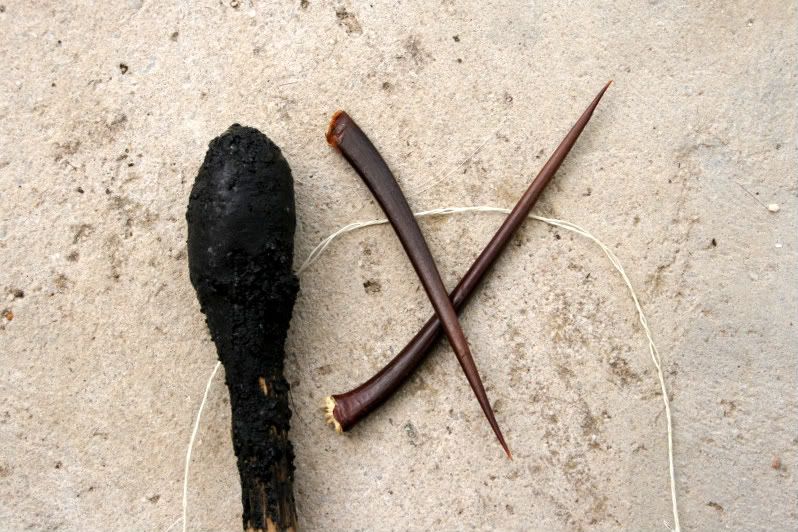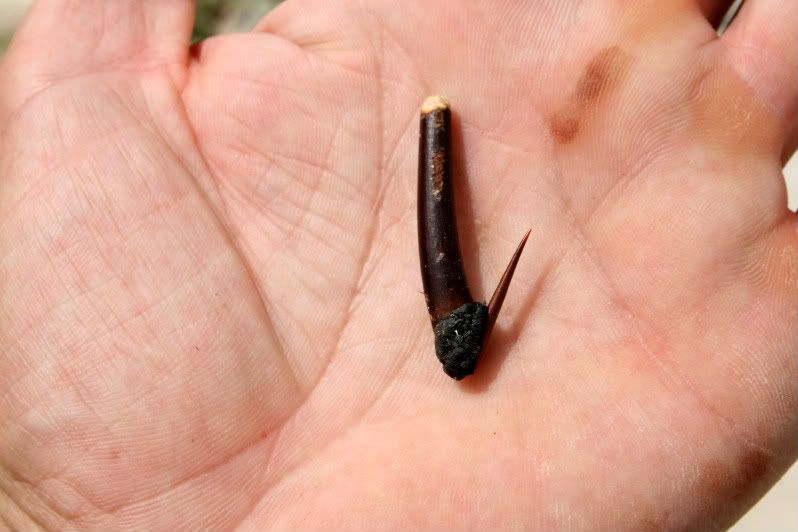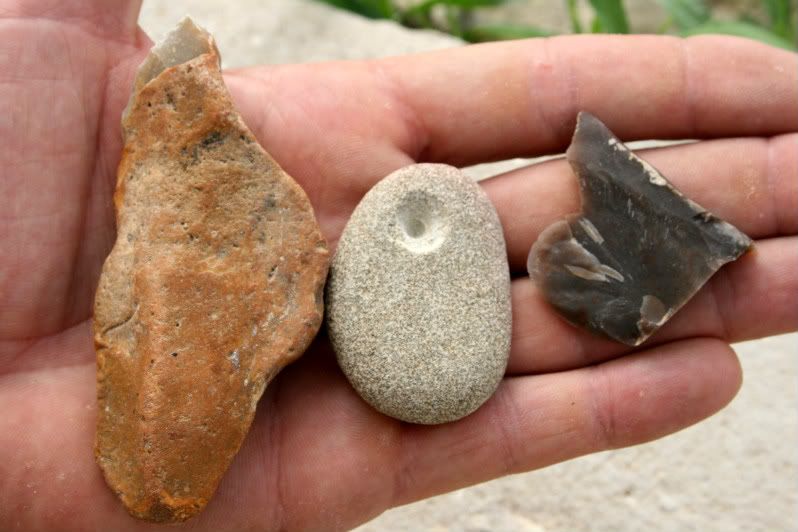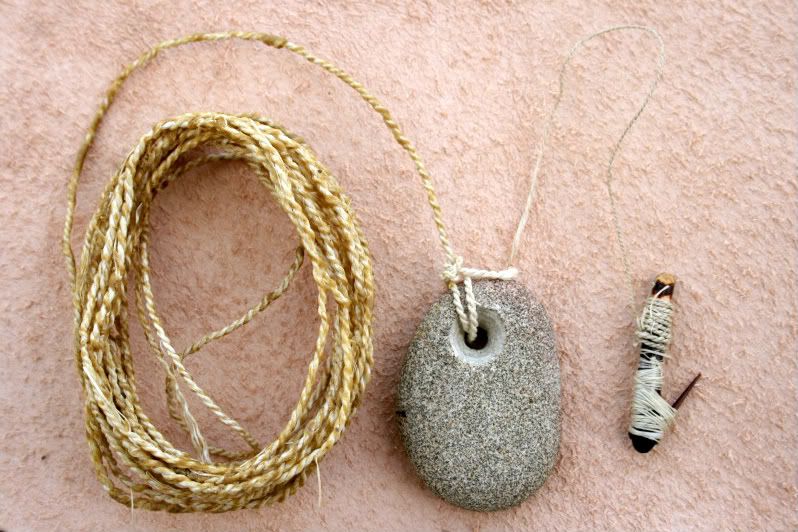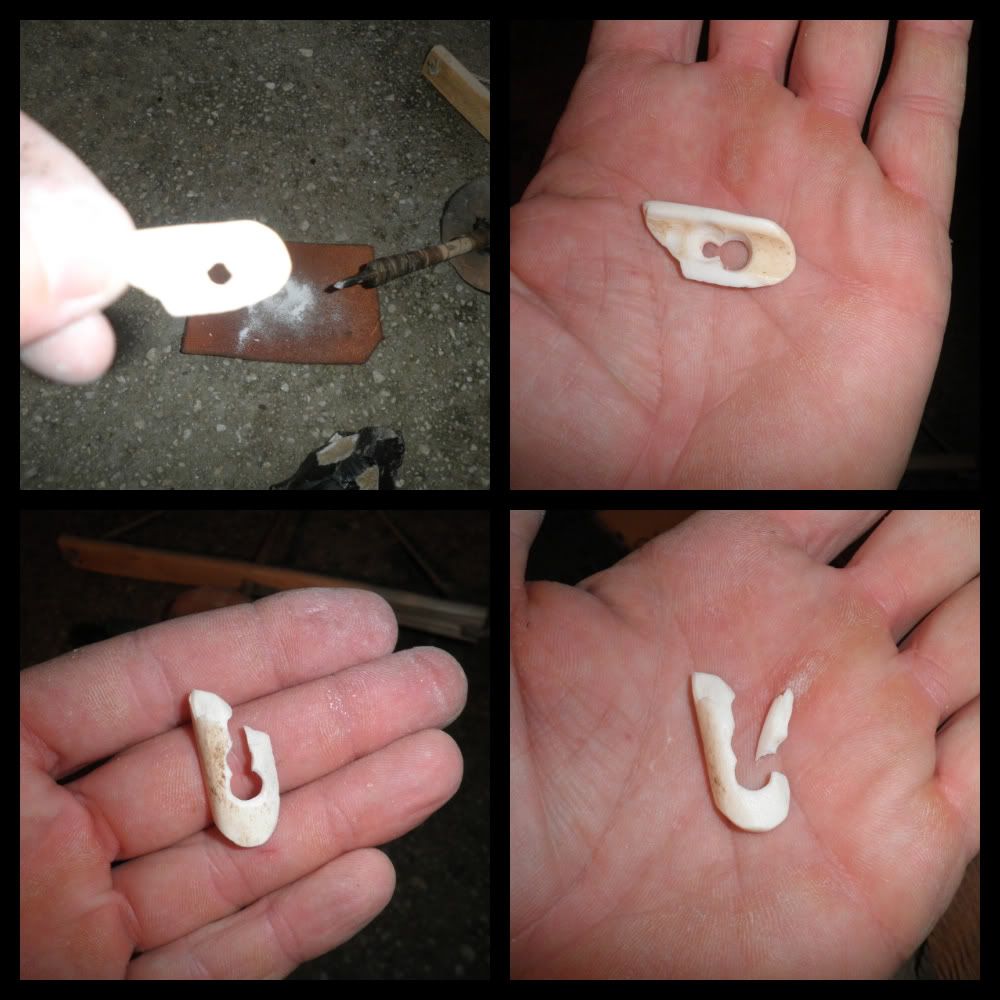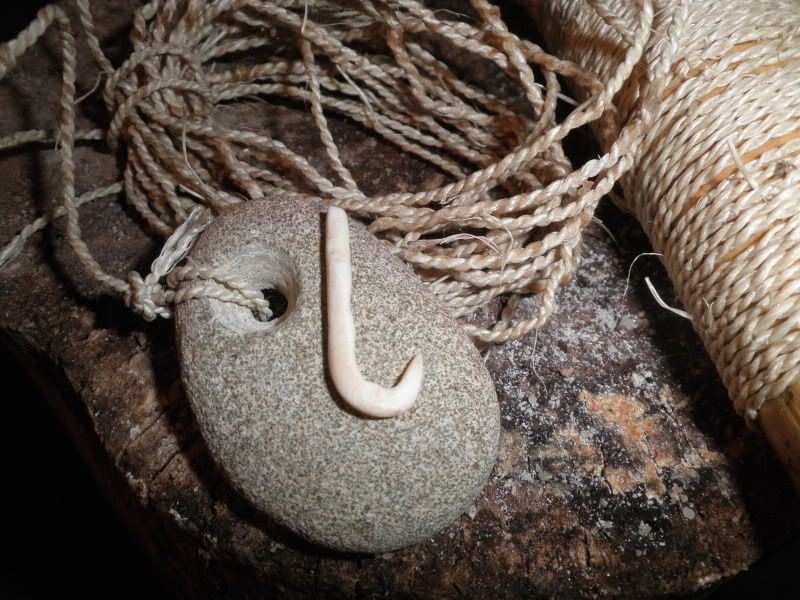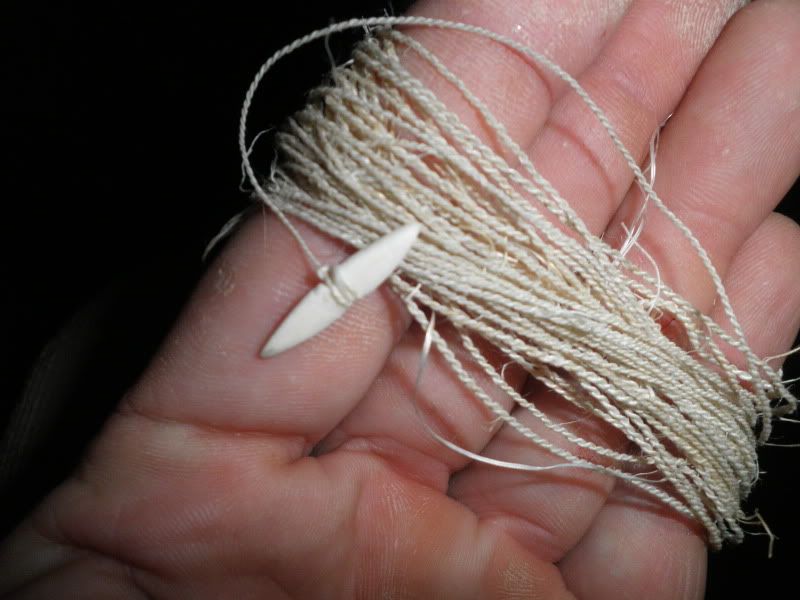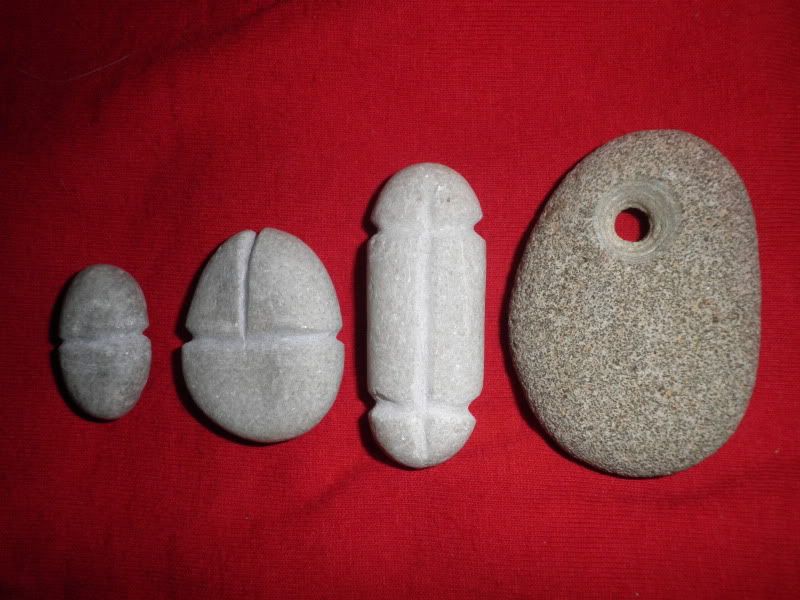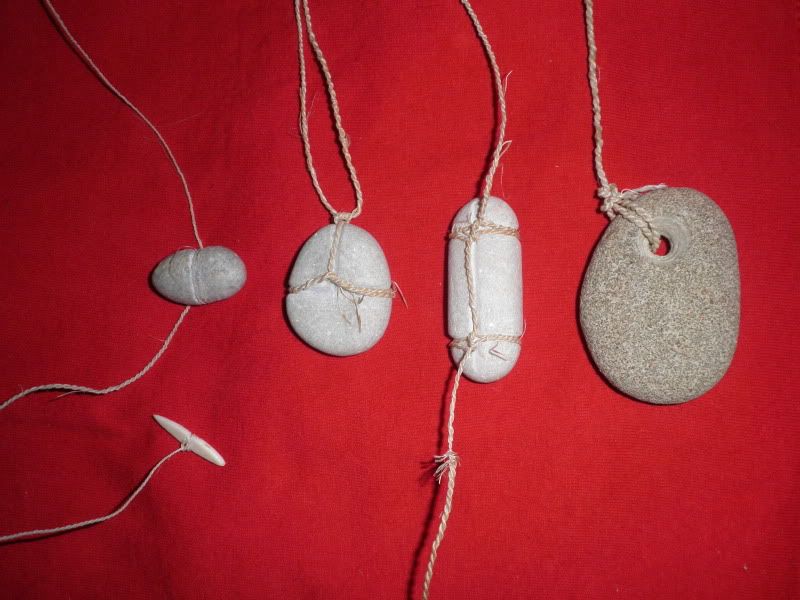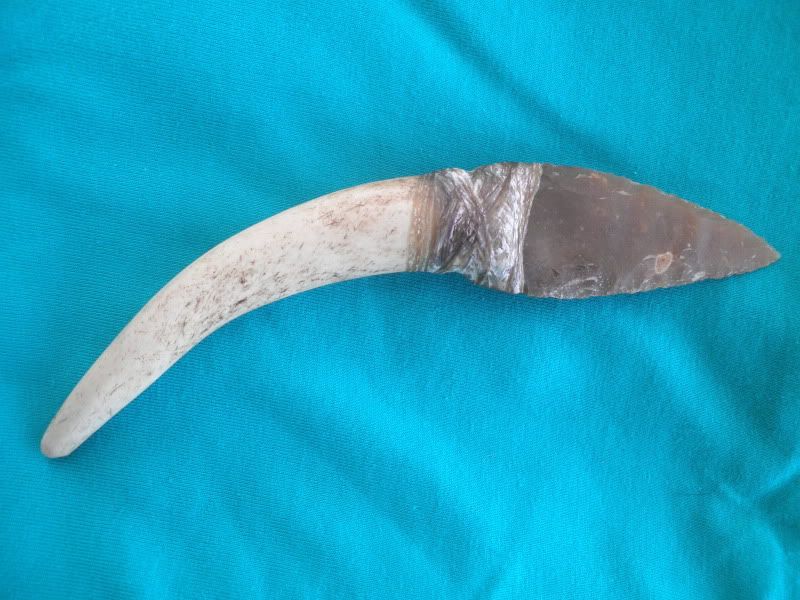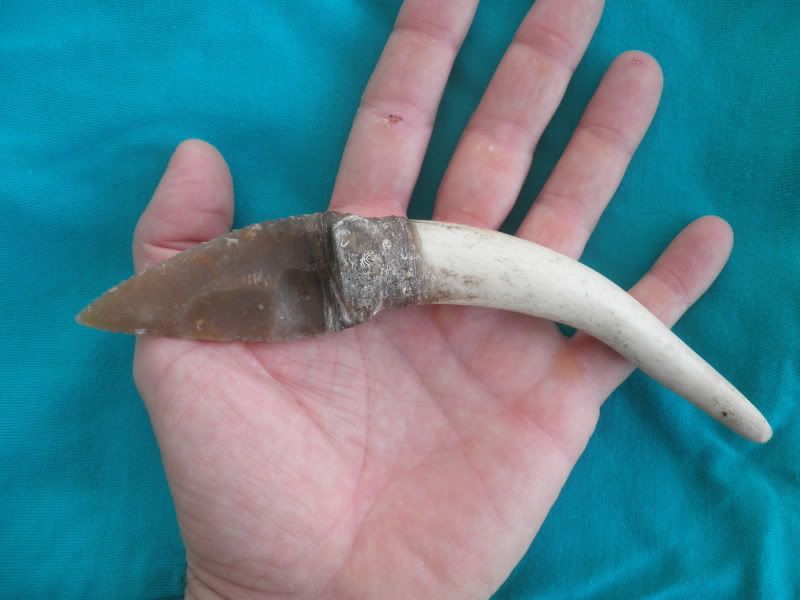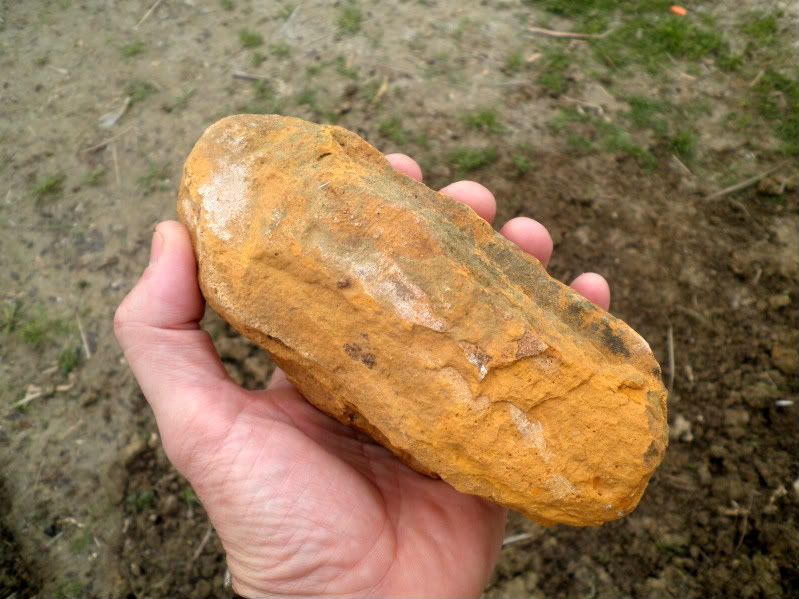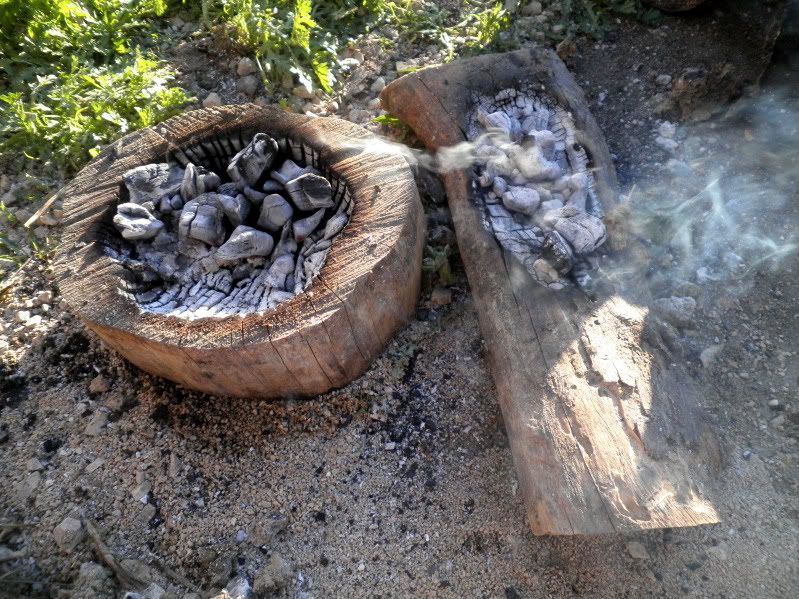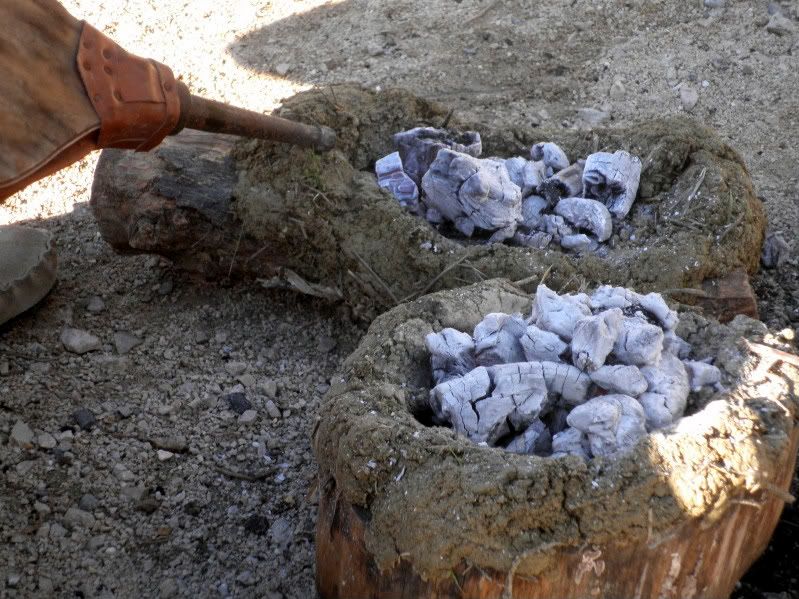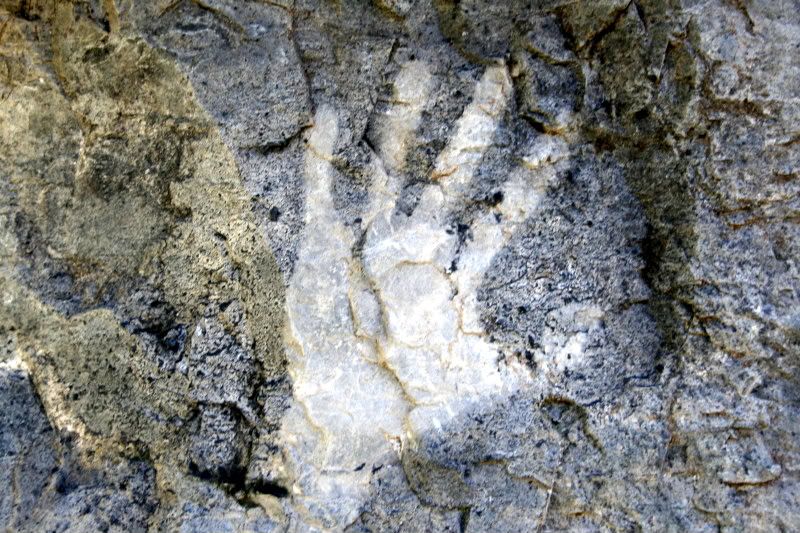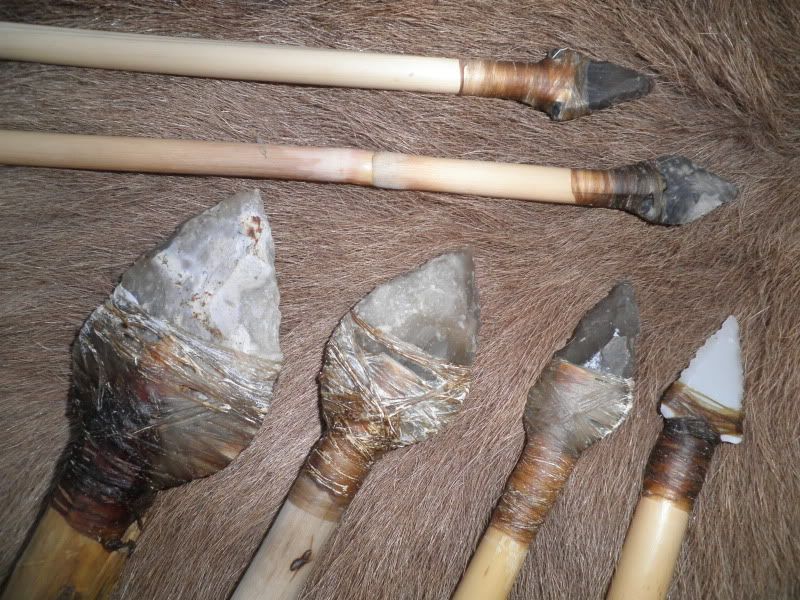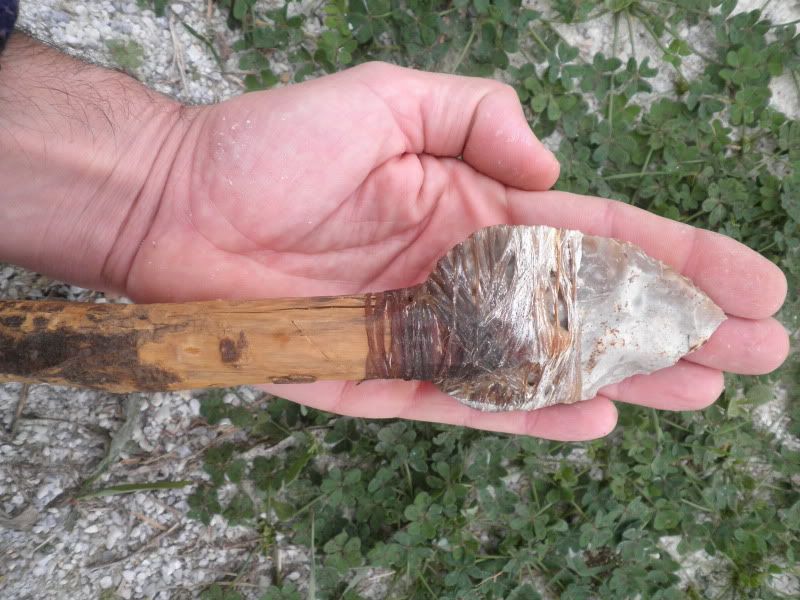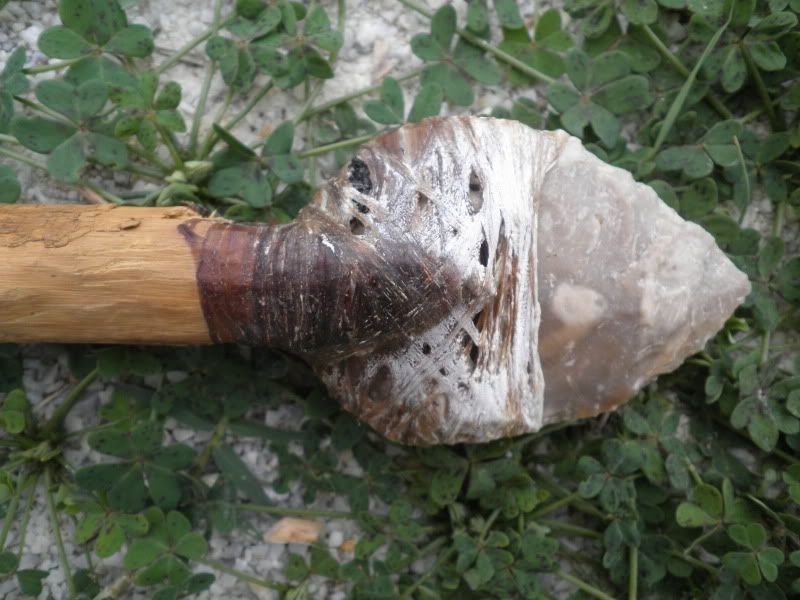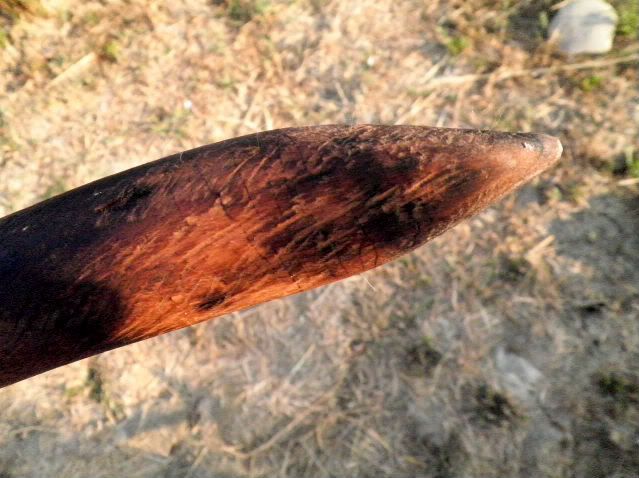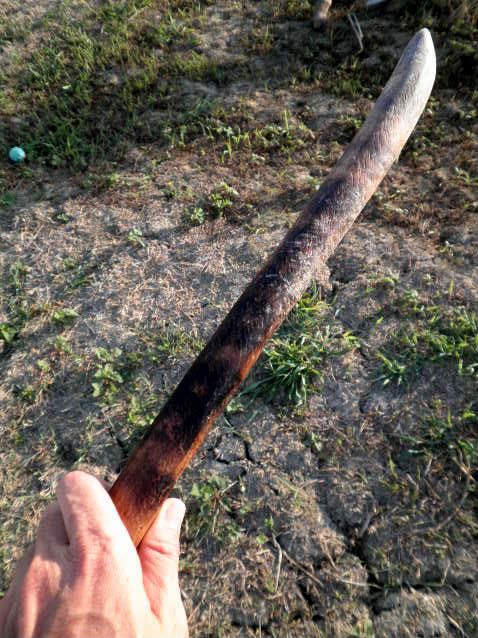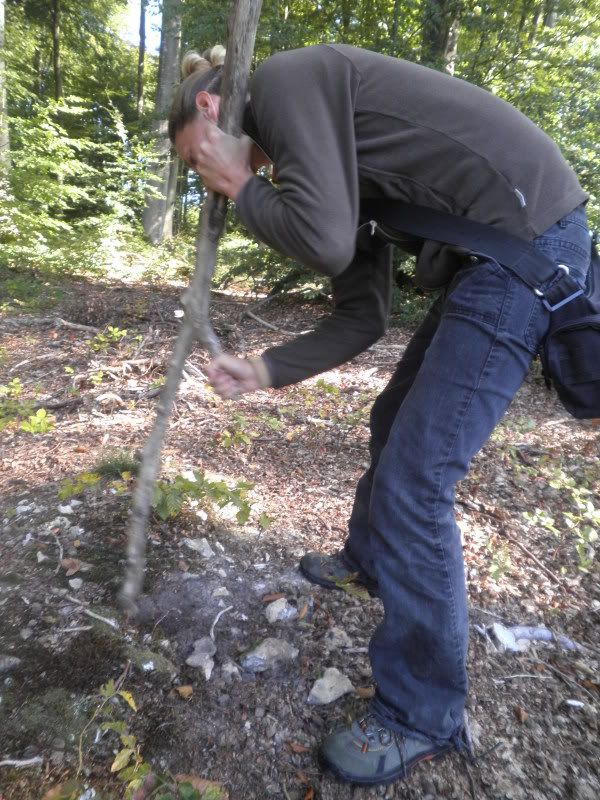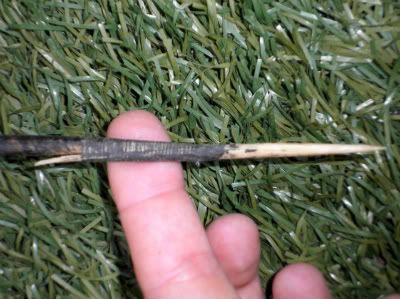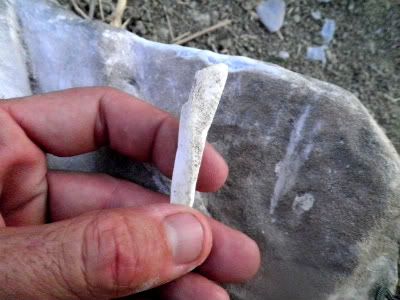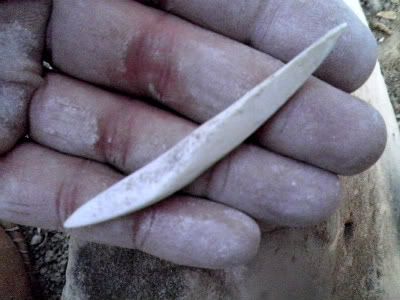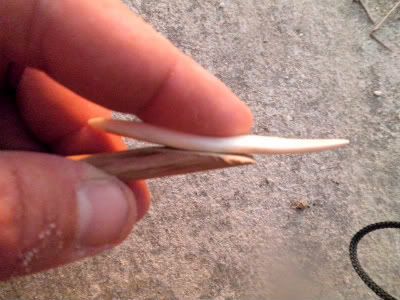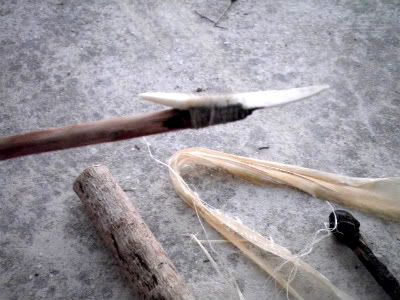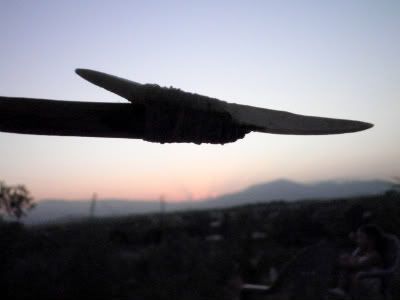This is my last atlatl, inspired by those of the Basketmaker people, a culture from the southwest of the USA, ancestral to Anasazi, who made very thin and light atlatls,
jueves, 21 de abril de 2011
Propulsor estilo "Basketmaker" / Basketmaker style atlatl
Este es mi último propulsor, inspirado en los atlatl de los Basketmaker, la cultura del suroeste de los EEUU predecesores de los Anasazi, unos atlatl que solían ser muy finos y ligeros.
domingo, 17 de abril de 2011
Anzuelo de los nativos americanos de la costa noroeste / Northwest coast native american hook
Esta es la reproducción que hice de un anzuelo de los que tradicionalmente usaban los nativos americanos de la costa noroeste. Es algo que quería hacer desde que los ví en el libro http://www.amazon.com/Indian-Fishing-Early-Methods-Northwest/dp/0295958030, así que hace unos días me puse a ello usando una ramita de acebuche y un trozo de asta de ciervo, atado con fibra de pita.
This is the reproduction i made of a hook traditionally used by native americans on the northwest coast. It is samething i wanted to make since i saw them first time in this book http://www.amazon.com/Indian-Fishing-Early-Methods-Northwest/dp/0295958030, so a couple of days ago i made one using a wild olive tree little piece of branch and a piece of deer antler, tied with agave fiber.
This is the reproduction i made of a hook traditionally used by native americans on the northwest coast. It is samething i wanted to make since i saw them first time in this book http://www.amazon.com/Indian-Fishing-Early-Methods-Northwest/dp/0295958030, so a couple of days ago i made one using a wild olive tree little piece of branch and a piece of deer antler, tied with agave fiber.
martes, 8 de febrero de 2011
Más puntas de flecha / Some more arrow points
Estas son algunas de las puntas de flecha que he hecho últimamente (aunque aún no he hecho mi propio arco) una de ellas enmangada con pegamento de resina de pino y atado con tendón de ciervo y decorada con sangre.
These are some of my latest arrow points i made (although i didnt make my own bow yet) one of them tied using pine pitch glue and deer sinew and decorated with blood.
lunes, 7 de febrero de 2011
Mi último propulsor / My last atlatl
El verano pasado conseguí esta piel de culebra http://elblogdetriballica.blogspot.com/search/label/PIEL%20DE%20SERPIENTE%20%2F%20SNAKE%20SKIN que guardé por estos meses con la esperanza de encontrar en qué emplearla. Hace unos pocos días, mientras me hacía un nuevo propulsor, pensé que igual la piel quedaría bien en él, tal y como los nativos americanos solían hacer con algunos de sus arcos. Así que eso es lo que hice. El propulsor, hecho a partir de una rama de avellano y con un gancho hecho con hueso de vaca, es bastante ligero y la piel ha resultado ser justa para cubrir el diámetro completo.
Last summer i got this snake´s skin http://elblogdetriballica.blogspot.com/search/label/PIEL%20DE%20SERPIENTE%20%2F%20SNAKE%20SKIN that i kept all this mounths hoping to find out how to use it. Just a few days ago, while making a new atlatl i thought that that skin could look nice on it, just like native americans used to do with some of their bows. So that´s what i did. The atlatl, made out of a hazel branch with a cow bone spur it´s quite light and the skin is just enough to cover it.
sábado, 15 de enero de 2011
Trampa de losa / Deadfall trap
Me atrae el ingenio empleado en la construcción de las trampas, una forma muy recurrente de obtener comida.Como quiero ponerme al día con este tema, he empezado por una muy típica, la de caida de losa. La trampa la componen tres palos que montados forman un "4" y estos sujetan la piedra. En el palo horizontal, que hace las veces de disparador, se coloca el cebo. En cuanto el animal trata de hacrese con él, salta el sistema dejando caer la piedra sobre el animal, como se muestra en el video.
I find trapping so clever and such a good way of getting food...I want to learn a few of them so i started with a classic one, the figure 4 deadfall. The trap is buid using three sticks that once set up they form a "4", holding a stone or log. The horizontal stick, the trigger, is where you place the bait; as soon as the animal tries to get the food, it springs the trap, letting the weight to fall on ifself, as shown on the video.
I find trapping so clever and such a good way of getting food...I want to learn a few of them so i started with a classic one, the figure 4 deadfall. The trap is buid using three sticks that once set up they form a "4", holding a stone or log. The horizontal stick, the trigger, is where you place the bait; as soon as the animal tries to get the food, it springs the trap, letting the weight to fall on ifself, as shown on the video.
OJO: EL TRAMPEO EN ESPAÑA ESTÁ PROHIBIDO, ADEMÁS DE SER UNA PRÁCTICA CRUEL.
domingo, 9 de enero de 2011
Anzuelos, pesos y sedales / Hooks, sinkers and lines
Me gustan las formas de obtener comida de forma primitiva; tan básica pero a la vez tan ingeniosa. A continuación, muestro algunos anzuelos y pesos que he hecho ultimamente inspirado en los nativos americanos
Este primero lo hice con una pua, creo que de acacia, con un poco de pegamento de resina de pino y fibra de pita...
I like the primitive ways to get food; basic but so clever.Nextí´ll show you some hooks and sinkers i´ve made lately (inspired by native americans fishing gear)
This first hook is made out of a thorn from a tree (acacia, i think) with a bit of pine pitch glue and some agave fiber...
Este primero lo hice con una pua, creo que de acacia, con un poco de pegamento de resina de pino y fibra de pita...
I like the primitive ways to get food; basic but so clever.Nextí´ll show you some hooks and sinkers i´ve made lately (inspired by native americans fishing gear)
This first hook is made out of a thorn from a tree (acacia, i think) with a bit of pine pitch glue and some agave fiber...
El peso lo hice perforando una piedra, usando para ello unos trozos de sílex
The sinker was made with a stone i drilled using two flint pieces
El anzuelo y el peso atados al sedal de fibra de pita
Hook and sinker tied to the agave line
A continuación, otro anzuelo, esta vez de hueso, que perforé usando un parafuso ("pump drill"), que puede verse al fondo en la primera foto. Desafortunadamente, se me rompió parcialemnte, por lo que no sé si llegará a ser realmente efectivo...
Next is a bone hook i made using a pump drill you can see in the first pic. Un fortunaly, it broke partially, so i´m not sure it will get me any fish...
El siguiente anzuelo es también de hueso, si bien de un diseño y elaboración mucho más sencillo, aunque no por ello deja de ser efectivo.
Next one is another bone one, much easier on design and manufacture, but quite efective
Por último, tres pesos más en piedra (junto al ya mostrado) que preparé acanalándolos para poder acoplar el sedal, como se muestra en la última foto
Last, three stone sinkers (next to the one already shown) i prepared so they can be tied with the line, as shown in last pic.
sábado, 8 de enero de 2011
Mi último cuchillo / My last knife
Este es el último que he hecho hasta la fecha, a partir de una lámina de sílex que me regaló mi amigo Daniel de PaleoForo, enmengada en asta de ciervo con pegamento de resina de pino y tripa de cordero.
My last knife so far, from a large flake that my friend from PaleoForo Daniel gave me, it is hafted in deer horn with pine pitch glue and sheep guts.
My last knife so far, from a large flake that my friend from PaleoForo Daniel gave me, it is hafted in deer horn with pine pitch glue and sheep guts.
domingo, 2 de enero de 2011
Pigmentos naturales / Natural pigments
Es un hecho que algunas rocas pueden transformar sus propiedades aplicándoles calor; Algunas clases de sílex se vuelven más tallables si son "cocinados" en cierta manera, y había leido que algunas piedras pueden cambiar su color gracias al fuego (http://www.primitiveways.com/paint_a_mammoth.html) En dicho artículo, se dice que se puede cambiar el color del amarillo al rojo por medio del fuego. Así que decidí probar con una de las piedras amarillas que tengo, que recogí en el río y el resultado fué sorprendente...
Is a fact that some stones can change their properties heating them; some types of flint will became more knappable if they are cook in certain ways, and i read that some stones could change their colour thanks to fire (http://www.primitiveways.com/paint_a_mammoth.html) In this article they say that the yellow colour of a stone could be change to red if cooked. So i decided to try with one of the yellow stones i´ve got, picked up in a river close to home, and this is the surprising result
Is a fact that some stones can change their properties heating them; some types of flint will became more knappable if they are cook in certain ways, and i read that some stones could change their colour thanks to fire (http://www.primitiveways.com/paint_a_mammoth.html) In this article they say that the yellow colour of a stone could be change to red if cooked. So i decided to try with one of the yellow stones i´ve got, picked up in a river close to home, and this is the surprising result
El fuego como herramienta / Using fire as a tool
El fuego puede ser usado, entre otras cosas como una herramienta; nos puede ayudar a realizar un trabajo. O al menos, lo podemos usar para que una tarea nos resulte más fácil. Como ejemplo, me gustaría mostrar estas fotos, en las que usando brasas de una hoguera logré hacer un rebaje en unas piezas de madera para usarlas como cuencos o morteros, tarea que, de haber tenido que realizar sin herramientas modernas, habría resultado muy penosa
Fire can be used as a tool, too; it can help us to make a job. Or at least, we can use it to make this job easier. As an example, i´d like to show you this pics in which you can see how using coals in some pieces of wood to make a mortar or a bowl. Without the help of fire,and with no modern tools, this job would have been quite hard
.
Fire can be used as a tool, too; it can help us to make a job. Or at least, we can use it to make this job easier. As an example, i´d like to show you this pics in which you can see how using coals in some pieces of wood to make a mortar or a bowl. Without the help of fire,and with no modern tools, this job would have been quite hard
.
Usando barro para controlar las zonas donde no queremos que el fuego actue
Mud can be used to avoid the coals to get to close to the border
Una vez que hemos obtenido lo que queríamos usando el fuego, podemos proceder a terminar. Usando una piedra rota podemos deshacernos de la parte quemada, como con esta otra pieza de madera, destinada a ser un mortero...
Once we get what we wanted using fire, we can finish the job. Just using a broken stone to get rid of the burned parts, like is shown in next picture with this other piece of wood, wich eventually will became a mortar
Con arena y un canto rodado, lijamos el interior
Using sand and a cobble to "polish" the interior
para obtener un mortero
to get, then, a mortar
lunes, 20 de diciembre de 2010
Cómo hacer cuerda / How to make a string
Un corto video acerca de cómo hago mis cuerdas. No es ni el único método ni el mejor, simplemente es al que estoy acostumbrado.
A short video on rope making. This is not the only way to do it nor the best one, it´s just the way i´m used to.
A short video on rope making. This is not the only way to do it nor the best one, it´s just the way i´m used to.
sábado, 30 de octubre de 2010
Arte primitivo / Primitive art
El verano pasado, mientras pasábamos unos días de vacaciones, quise probar a hacer una pequeña prueba; machaqué, lo más finamente posible. restos de carbón de una hoguera y lo mezclé con agua. Después, busqué una pared de piedra, coloqué mi mano sobre ella y, con la mezcla de carbón y agua en la boca, soplé sobre mi mano, procurando que la mezcla saliera bien dispersa. Aquí podéis ver el resultado. No del todo mal para ser la primera vez.
Last summer, while having some days off, i tried to test something i´ve got in my head for a while; i mixed fine crushed charcoal with water. Then i looked for a stone wall, i set my hand there and with some of the mix in my mouth, i blew over it, trying to get a good spray effect. This is the result. Not too bad...
Puntas de lanza, azagaya y flechas / Spear, atlatl dart and arrows points
Unas cuantas puntas que hice la última vez que estuve en Normandía y que enmangué hace unos días ya. Estoy especialmente orgulloso de la lanza, de más de dos metros de largo y con ese aspecto crudo que me encanta. he usado sólo tripa de cabra.
Some flint points i made in my last vivit to Normandy, hafted some days ago. I feel quite proud of the big spear; two meters long and quite rough look that i love. I used just goat gut to haft them.
Some flint points i made in my last vivit to Normandy, hafted some days ago. I feel quite proud of the big spear; two meters long and quite rough look that i love. I used just goat gut to haft them.
Cuchillo de sílex / Flint knife
Ayer terminé esta hoja de sílex, que he enmangado en asta de ciervo usando pegamento de resina de pino y tripa de cabra.
Yesterday, i finished this flint blade, which i hafted in deer antler using pine pitch glue and goat gut.
Yesterday, i finished this flint blade, which i hafted in deer antler using pine pitch glue and goat gut.
miércoles, 13 de octubre de 2010
Palo de escavar / Digging stick
Esta es una herramienta básica usada desde antaño en diferentes partes del planeta. No es más que un palo afilado en su extremo, que se usa para extraer raices, o para buscar larvas, insectos o roedores (y en estos menesteres, el palo tiene la ventaja sobre el cuchillo de que no daña lo que quieres obtener) para hacer boquetes en el suelo (para preparar tampas o para preparar un fuego, por ejemplo) o para desenterrar cualquier otra cosa. En realidad, el palo de escarbar se puede improvisar fácilmente cuando hace falta, pero yo he decidido hacerme uno (con una rama de olivo, tostado al fuego para endurezerlo y terminado con cera de abeja) que además, me sirve como palo para caminar y de defensa-ahuyenta perros.
This is a very basic tool used since very early and in differnts parts of the planet. It´s just a stick with a, somehow, sharp end, used to get roots, insects, small rodents, etc ( and for these tasks the stick is better than a knife as this could damage what we want to dig). It ´s also good to make holesin the ground To prepare a trap or a fire bed or to dig anything else. Actually, the digging stick can be improvise when you need it, but i wanted to make one to keep it (made ot of an olive tree branch, heated with fire and coated with beewax) and used as a walking stick and a keepawayangrydogs-stick too.
Usando un palo de escarvar improvisado para desenterrar sílex en los bosques de Normandía.
Using an improvise digging stick to get flint in one of Normandy´s forests.
lunes, 30 de agosto de 2010
Cuando no hay piedra tallable disponible / When there is not knappable stone around
Son muchas las culturas y pueblos que, obligados por la escasez de piedra tallable, han usado otros materiales, como hueso, conchas y diferentes tipos de madera.
Una opción sería hacer algo parecido a lo que hacen los yanomami, usar un hueso alargado para obtener una punta para sus arpones y flechas.
Una opción sería hacer algo parecido a lo que hacen los yanomami, usar un hueso alargado para obtener una punta para sus arpones y flechas.
Auténtica punta de arpón yanomami (propiedad de mi amigo José Ogalla). Obsérvese la parte trasera del hueso colocado de manera tal que forma la parte que impedirá que la presa se desprenda del arpón.
Real yanomami harpoon point (owned by my friend josé Ogalla). Check out the bone´s rear end, placed in such a way that it will avoid to get out of the fish or animal.
Trabajando un trozo de hueso, con una forma similar a lo que busco, contra una piedra porosa...
Working on a piece of bone with the right shape, against a porous stone...
Se obtiene algo que puede servir para nuestra punta de proyectil.
We get something that could be our projectile point.
La punta de nuestro astil tiene que tener el ángulo adecuado.
The shaft has to be shaped in the right angle.
Lo pego con resina de pino.
Sticking it using pine pitch glue.
...y lo ato con tendón de ciervo,
...and i tied it using deer sinew.
Y la punta de inspiración yanomami está terminada. Me gusta ver cómo diferentes soluciones se dan para un mismo problema en diferentes partes del mundo, usando lo que se tiene a mano.
And the yanomami inspired point is finished. I like to see how different solutions have been found for the same problem in diferent parts of the world, using whatever the material is at hand
Suscribirse a:
Entradas (Atom)


